engine Hyundai Elantra GT 2013 Owner's Manual
[x] Cancel search | Manufacturer: HYUNDAI, Model Year: 2013, Model line: Elantra GT, Model: Hyundai Elantra GT 2013Pages: 476, PDF Size: 31.71 MB
Page 4 of 476
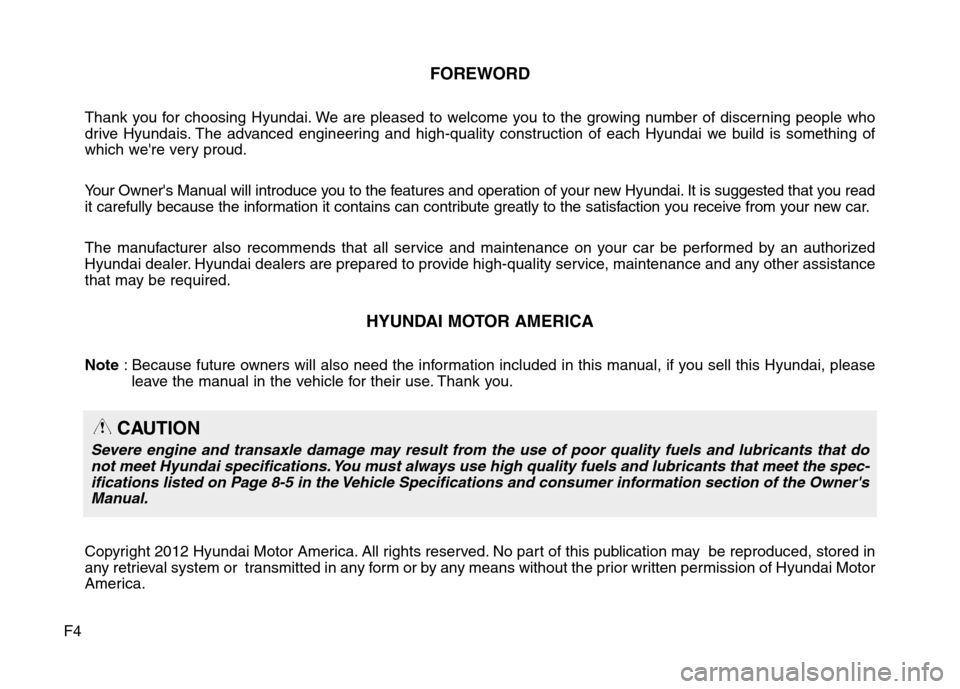
F4
FOREWORD
Thank you for choosing Hyundai. We are pleased to welcome you to the growing number of discerning people who
drive Hyundais. The advanced engineering and high-quality construction of each Hyundai we build is something of
which we're very proud.
Your Owner's Manual will introduce you to the features and operation of your new Hyundai. It is suggested that you read
it carefully because the information it contains can contribute greatly to the satisfaction you receive from your new car.
The manufacturer also recommends that all service and maintenance on your car be performed by an authorized
Hyundai dealer. Hyundai dealers are prepared to provide high-quality service, maintenance and any other assistance
that may be required.
HYUNDAI MOTOR AMERICA
Note: Because future owners will also need the information included in this manual, if you sell this Hyundai, please
leave the manual in the vehicle for their use. Thank you.
Copyright 2012 Hyundai Motor America. All rights reserved. No part of this publication may be reproduced, stored in
any retrieval system or transmitted in any form or by any means without the prior written permission of Hyundai Motor
America.
CAUTION
Severe engine and transaxle damage may result from the use of poor quality fuels and lubricants that do
not meet Hyundai specifications. You must always use high quality fuels and lubricants that meet the spec-
ifications listed on Page 8-5 in the Vehicle Specifications and consumer information section of the Owner's
Manual.
Page 6 of 476
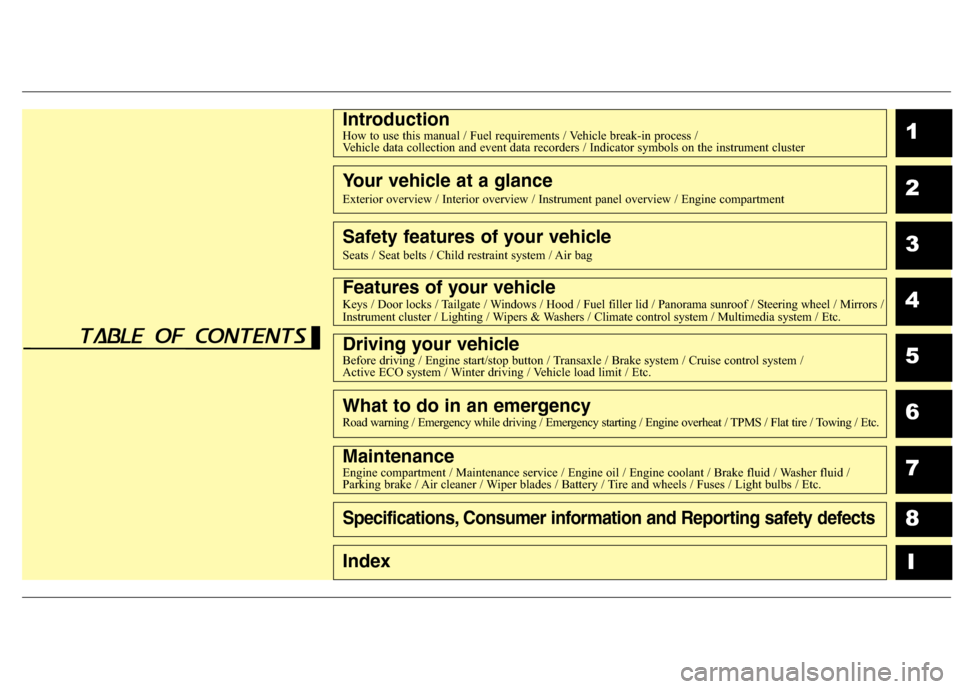
1
2
3
4
5
6
7
8
I
IntroductionHow to use this manual / Fuel requirements / Vehicle break-in process /
Vehicle data collection and event data recorders / Indicator symbols on the instrument cluster
Your vehicle at a glance
Exterior overview / Interior overview / Instrument panel overview / Engine compartment
Safety features of your vehicle
Seats / Seat belts / Child restraint system / Air bag
Features of your vehicleKeys / Door locks / Tailgate / Windows / Hood / Fuel filler lid / Panorama sunroof / Steering wheel / Mirrors /
Instrument cluster / Lighting / Wipers & Washers / Climate control system / Multimedia system / Etc.
Driving your vehicleBefore driving / Engine start/stop button / Transaxle / Brake system / Cruise control system /
Active ECO system / Winter driving / Vehicle load limit / Etc.
What to do in an emergencyRoad warning / Emergency while driving / Emergency starting / Engine overheat / TPMS / Flat tire / Towing / Etc.
MaintenanceEngine compartment / Maintenance service / Engine oil / Engine coolant / Brake fluid / Washer fluid /
Parking brake / Air cleaner / Wiper blades / Battery / Tire and wheels / Fuses / Light bulbs / Etc.
Specifications, Consumer information and Reporting safety defects
Index
table of contents
Page 10 of 476
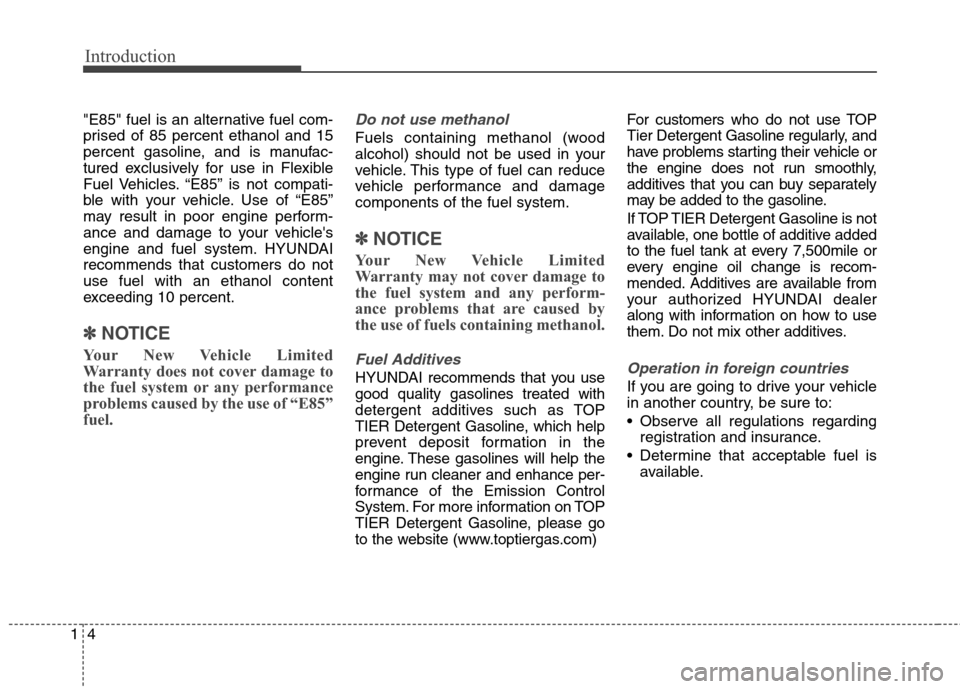
Introduction
4 1
"E85" fuel is an alternative fuel com-
prised of 85 percent ethanol and 15
percent gasoline, and is manufac-
tured exclusively for use in Flexible
Fuel Vehicles. “E85” is not compati-
ble with your vehicle. Use of “E85”
may result in poor engine perform-
ance and damage to your vehicle's
engine and fuel system. HYUNDAI
recommends that customers do not
use fuel with an ethanol content
exceeding 10 percent.
✽ ✽
NOTICE
Your New Vehicle Limited
Warranty does not cover damage to
the fuel system or any performance
problems caused by the use of “E85”
fuel.
Do not use methanol
Fuels containing methanol (wood
alcohol) should not be used in your
vehicle. This type of fuel can reduce
vehicle performance and damage
components of the fuel system.
✽ ✽
NOTICE
Your New Vehicle Limited
Warranty may not cover damage to
the fuel system and any perform-
ance problems that are caused by
the use of fuels containing methanol.
Fuel Additives
HYUNDAI recommends that you use
good quality gasolines treated with
detergent additives such as TOP
TIER Detergent Gasoline, which help
prevent deposit formation in the
engine. These gasolines will help the
engine run cleaner and enhance per-
formance of the Emission Control
System. For more information on TOP
TIER Detergent Gasoline, please go
to the website (www.toptiergas.com)For customers who do not use TOP
Tier Detergent Gasoline regularly, and
have problems starting their vehicle or
the engine does not run smoothly,
additives that you can buy separately
may be added to the gasoline.
If TOP TIER Detergent Gasoline is not
available, one bottle of additive added
to the fuel tank at every 7,500mile or
every engine oil change is recom-
mended. Additives are available from
your authorized HYUNDAI dealer
along with information on how to use
them. Do not mix other additives.Operation in foreign countries
If you are going to drive your vehicle
in another country, be sure to:
Observe all regulations regarding
registration and insurance.
Determine that acceptable fuel is
available.
Page 11 of 476
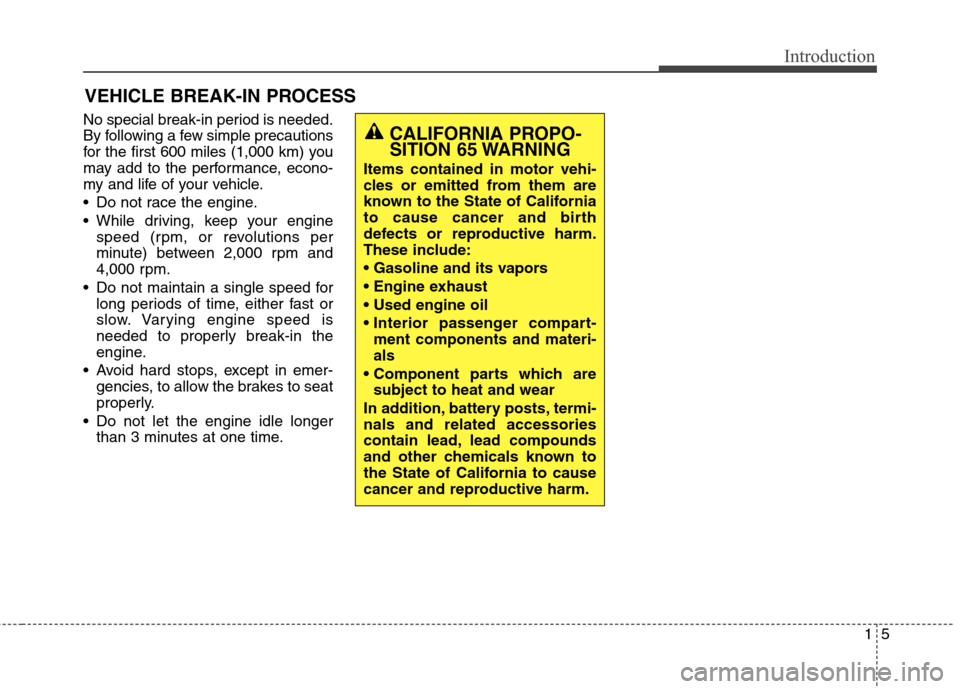
15
Introduction
VEHICLE BREAK-IN PROCESS
No special break-in period is needed.
By following a few simple precautions
for the first 600 miles (1,000 km) you
may add to the performance, econo-
my and life of your vehicle.
Do not race the engine.
While driving, keep your engine
speed (rpm, or revolutions per
minute) between 2,000 rpm and
4,000 rpm.
Do not maintain a single speed for
long periods of time, either fast or
slow. Varying engine speed is
needed to properly break-in the
engine.
Avoid hard stops, except in emer-
gencies, to allow the brakes to seat
properly.
Do not let the engine idle longer
than 3 minutes at one time.CALIFORNIA PROPO-
SITION 65 WARNING
Items contained in motor vehi-
cles or emitted from them are
known to the State of California
to cause cancer and birth
defects or reproductive harm.
These include:
ment components and materi-
als
subject to heat and wear
In addition, battery posts, termi-
nals and related accessories
contain lead, lead compounds
and other chemicals known to
the State of California to cause
cancer and reproductive harm.
Page 13 of 476

17
Introduction
INDICATOR SYMBOLS ON THE INSTRUMENT CLUSTER
Seat belt warning light
High beam indicator
Turn signal indicator
ABS warning light
Parking brake & Brake fluid
warning light
Engine oil pressure warning
light
Malfunction indicator light
Air bag warning light
Cruise indicator
Cruise SET indicator
Immobilizer indicator
Low fuel level warning light
Charging system warning
lightTail light indicator
Tailgate open warning light
Front fog light indicator
(if equipped)Low tire pressure telltale
(TPMS malfunction indicator)
(if equipped)
ECO indicator (if equipped)ECO
ESC indicator
(ESC malfunction indicator)
ESC OFF indicator
Electric power steering
(EPS) system warning light
(if equipped)
Electric parking brake (EPB)
malfunction indicator
(if equipped)
EPB
Door open position indicator
(if equipped)
* For more detailed explanations,
refer to “Instrument cluster” in sec-
tion 4.
Page 14 of 476

Exterior overview I . . . . . . . . . . . . . . . . . . . . . . . . . 2-2
Exterior overview II. . . . . . . . . . . . . . . . . . . . . . . . . 2-3
Interior overview . . . . . . . . . . . . . . . . . . . . . . . . . . . 2-4
Instrument panel overview . . . . . . . . . . . . . . . . . . . 2-5
Engine compartment . . . . . . . . . . . . . . . . . . . . . . . . 2-6
2
Your vehicle at a glance
Exterior overview (front) ..........................................2-2
Exterior overview (rear) ..........................................2-3
Interior overview ......................................................2-4
Instrument panel overview ......................................2-5
Engine compartment ................................................2-6
2
Page 18 of 476
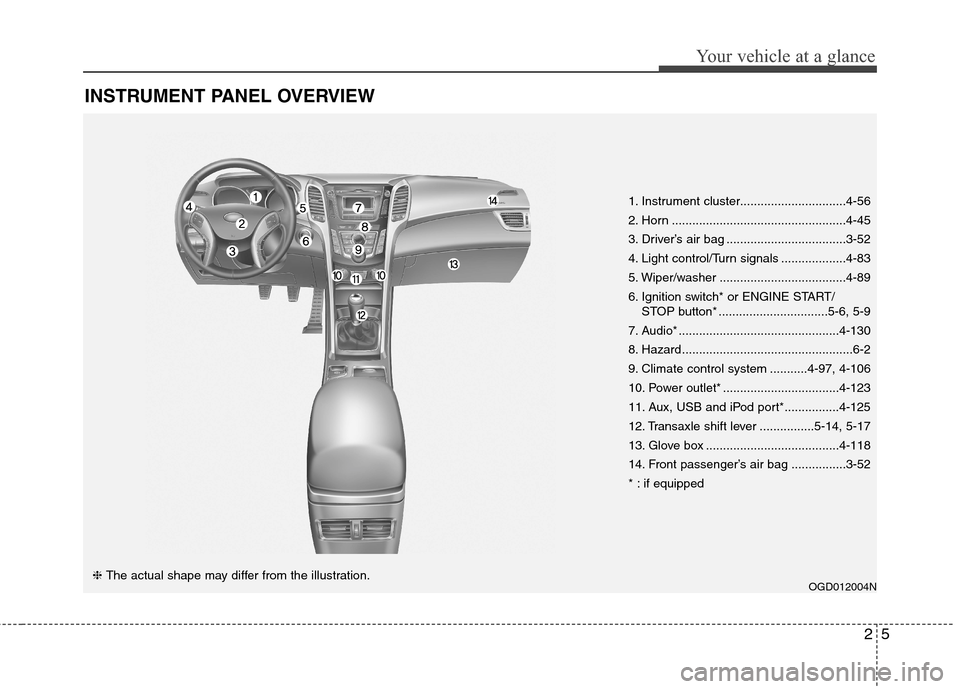
25
Your vehicle at a glance
INSTRUMENT PANEL OVERVIEW
OGD012004N❈ The actual shape may differ from the illustration.1. Instrument cluster...............................4-56
2. Horn ...................................................4-45
3. Driver’s air bag ...................................3-52
4. Light control/Turn signals ...................4-83
5. Wiper/washer .....................................4-89
6. Ignition switch* or ENGINE START/
STOP button* ................................5-6, 5-9
7. Audio* ...............................................4-130
8. Hazard..................................................6-2
9. Climate control system ...........4-97, 4-106
10. Power outlet* ..................................4-123
11. Aux, USB and iPod port*................4-125
12. Transaxle shift lever ................5-14, 5-17
13. Glove box .......................................4-118
14. Front passenger’s air bag ................3-52
* : if equipped
Page 19 of 476
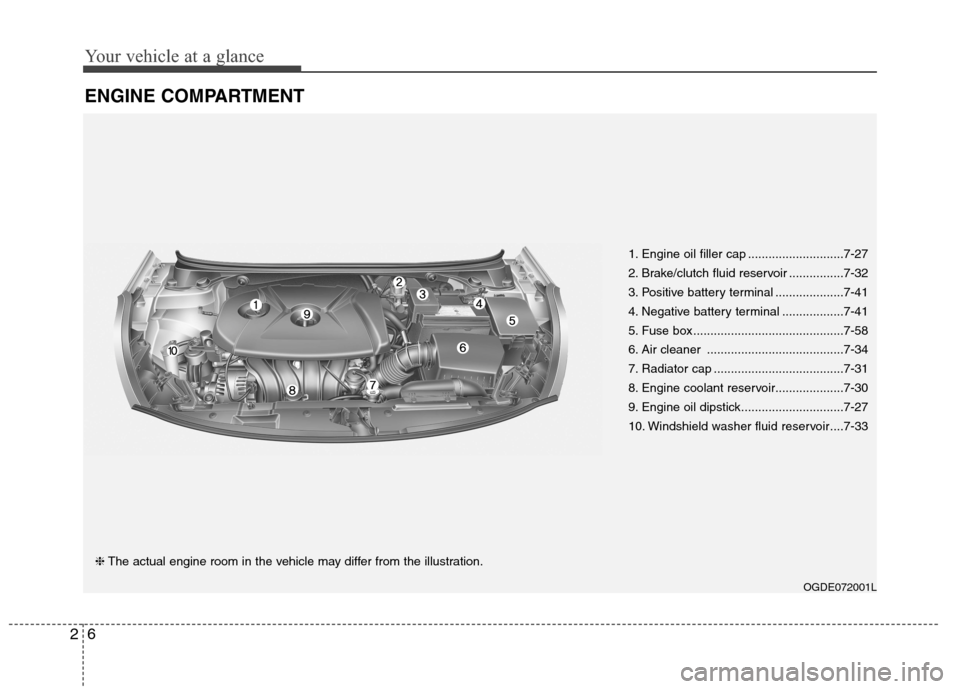
Your vehicle at a glance
6 2
ENGINE COMPARTMENT
OGDE072001L
❈The actual engine room in the vehicle may differ from the illustration.1. Engine oil filler cap ............................7-27
2. Brake/clutch fluid reservoir ................7-32
3. Positive battery terminal ....................7-41
4. Negative battery terminal ..................7-41
5. Fuse box ............................................7-58
6. Air cleaner ........................................7-34
7. Radiator cap ......................................7-31
8. Engine coolant reservoir....................7-30
9. Engine oil dipstick..............................7-27
10. Windshield washer fluid reservoir ....7-33
Page 25 of 476
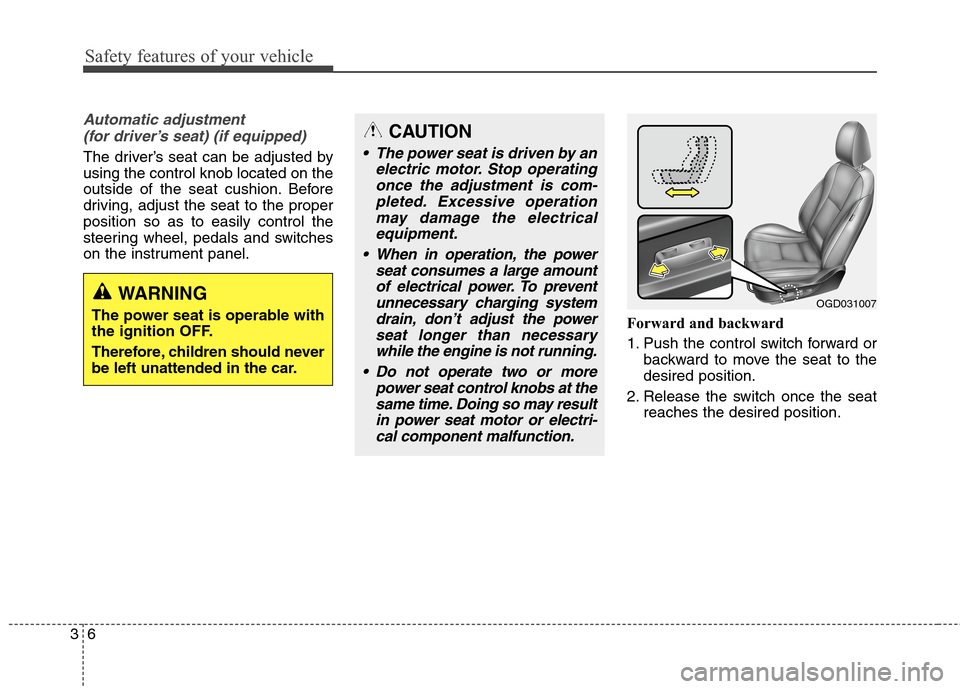
Safety features of your vehicle
6 3
Automatic adjustment
(for driver’s seat) (if equipped)
The driver’s seat can be adjusted by
using the control knob located on the
outside of the seat cushion. Before
driving, adjust the seat to the proper
position so as to easily control the
steering wheel, pedals and switches
on the instrument panel.
Forward and backward
1. Push the control switch forward or
backward to move the seat to the
desired position.
2. Release the switch once the seat
reaches the desired position.
WARNING
The power seat is operable with
the ignition OFF.
Therefore, children should never
be left unattended in the car.
CAUTION
The power seat is driven by an
electric motor. Stop operating
once the adjustment is com-
pleted. Excessive operation
may damage the electrical
equipment.
When in operation, the power
seat consumes a large amount
of electrical power. To prevent
unnecessary charging system
drain, don’t adjust the power
seat longer than necessary
while the engine is not running.
Do not operate two or more
power seat control knobs at the
same time. Doing so may result
in power seat motor or electri-
cal component malfunction.
OGD031007
Page 35 of 476
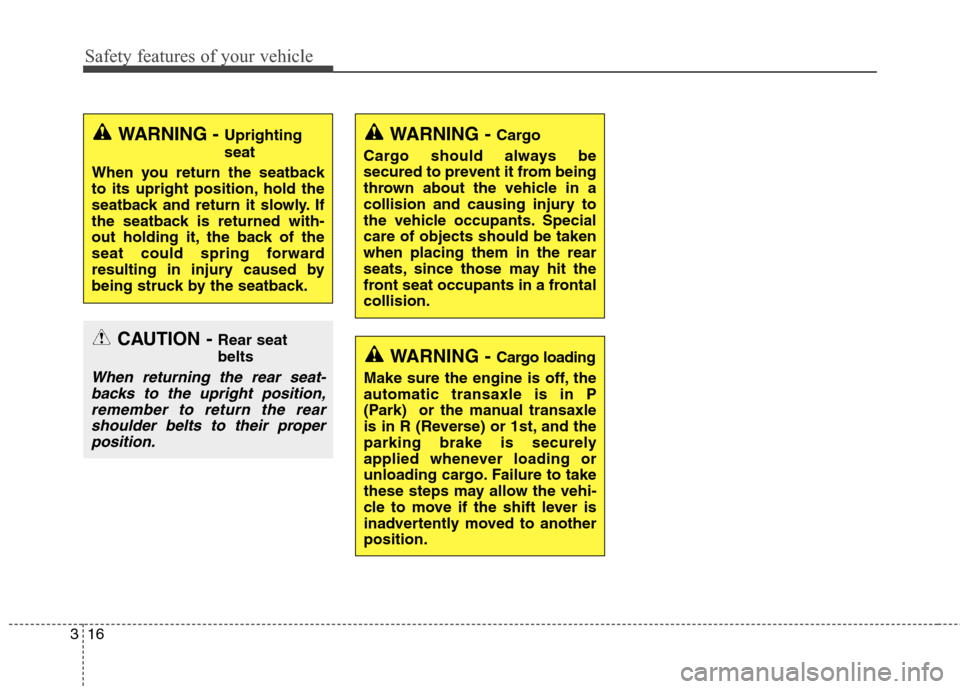
Safety features of your vehicle
16 3
WARNING - Cargo loading
Make sure the engine is off, the
automatic transaxle is in P
(Park) or the manual transaxle
is in R (Reverse) or 1st, and the
parking brake is securely
applied whenever loading or
unloading cargo. Failure to take
these steps may allow the vehi-
cle to move if the shift lever is
inadvertently moved to another
position.
WARNING - Cargo
Cargo should always be
secured to prevent it from being
thrown about the vehicle in a
collision and causing injury to
the vehicle occupants. Special
care of objects should be taken
when placing them in the rear
seats, since those may hit the
front seat occupants in a frontal
collision.
CAUTION - Rear seat
belts
When returning the rear seat-
backs to the upright position,
remember to return the rear
shoulder belts to their proper
position.
WARNING - Uprighting
seat
When you return the seatback
to its upright position, hold the
seatback and return it slowly. If
the seatback is returned with-
out holding it, the back of the
seat could spring forward
resulting in injury caused by
being struck by the seatback.